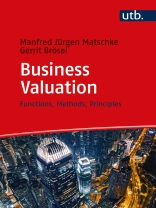And assigns them to the relevant function of business valuation. Breaking down business valuation into three stages is a major step toward improving the transparency of the process. The steps introduced in this book are 1. Determination of relevant data acquisition, 2. Transformation of relevant data in a value, 3. Use of the determined value. A key aspect of this textbook is its analysis of the valuation process from the perspective of both buyer and seller. Ultimately, the book will present readers with the key principles of functional business valuation, which if it had been applied more widely, the authors argue, could have mitigated the severity of at least some recent financial crises.
The book offers students, researchers, and practitioners interested in or involved in valuation clearly formulated learning goals and selected control questions. The systematic concept outlined also makes the book very well suited for self-study.
Cuprins
Preface V
Content Overview VII
List of Figures XV
List of Symbols XXI
1 Fundamentals of Business Valuation 1
1.1 Basic Terminology 3
1.2 Concepts of Business Valuation 11
1.2.1 Functional Business Valuation Theory via the German School 11
1.2.2 Neoclassical Business Valuation Theory via the Anglo-Saxon School 16
1.3 Occasions of Business Valuation 37
1.3.1 Requirement to Systematize Occasions of Business Valuation 37
1.3.2 Systematization of Occasions of Business Valuation According to the Main Functions 39
1.3.2.1 Conflict Situations of the Acquisition/Sale Type and of the Merger/Demerger Type 39
1.3.2.2 Non-dominated and Dominated Conflict Situations 41
1.3.2.3 Disjoint and Joint Conflict Situations 41
1.3.2.4 One-Dimensional and Multi-Dimensional Conflict Situations 42
1.4 Matrix of Functional Business Valuation and Overview of Methods of Business Valuation 46
1.4.1 Matrix of Functional Business Valuation 46
1.4.2 Overview of Methods of Business Valuation 48
1.5 Selected Control Questions 52
2 Decision Function and Decision Value 53
2.1 Basics 55
2.2 Determination of Multi-Dimensional Decision Values 60
2.2.1 Utility Values as Basics for Decision Value Determination 60
2.2.1.1 The Term “Utility Value” 60
2.2.1.2 Target Plan and Decision Field as Parameters of the
Utility Value 60
2.2.2 A General Model for the Determination of a Multi-Dimensional Decision Value 65
2.2.2.1 Determination of Decision Values as a Two-Step Calculation 65
2.2.2.2 Determination of the Base Program 65
2.2.2.3 Determination of the Valuation Program 66
2.2.2.4 Multi-Dimensional Decision Value 67
2.2.2.5 Set of the Acceptable Conflict Resolutions 69
2.2.2.6 Set of Agreement Resolutions 69
2.3 Determination of One-Dimensional Decision Values in Non-Dominated, Disjoint Conflict Situations of the Acquisition/Sale Type 70
2.3.1 Examination steps on the Matrix of Functional Business Valuation 70
2.3.1.1 Overview 70
2.3.1.2 The Steps in Detail 71
2.3.1.2.1 First Step 71
2.3.1.2.2 Second Step 75
2.3.1.2.3 Third step 77
2.3.2 Characterizing the Conflict Situation 79
2.3.3 Valuation Methods 82
2.3.3.1 Basic Models of Marginal Price Determination 82
2.3.3.1.1 Basic Model of Decision Value Determination 82
2.3.3.1.1.1 Determination of the Base Program 82
2.3.3.1.1.2 Determination of the Valuation Program 83
2.3.3.1.1.3 Numerical Example 84
2.3.3.1.2 Basic Model of the Present Value Calculation 94
2.3.3.1.2.1 Structural Equality of the Price Limit Calculation and the Present Value Calculation 94
2.3.3.1.2.2 Extended Interpretation of the Term “Comparison Object” based on the Present Value Calculation 96
2.3.3.2 The State Marginal Price Model – a General Model 97
2.3.3.2.1 Basics 97
2.3.3.2.2 The Model from the Presumptive Buyer’s Perspective 100
2.3.3.2.2.1 Presentation 100
2.3.3.2.2.2 Numerical Example 102
2.3.3.2.3 The Model from the Presumptive Seller’s Perspective 107
2.3.3.2.3.1 Presentation 107
2.3.3.2.3.2 Numerical Example 109
2.3.3.2.4 Consideration of Uncertainty 114
2.3.3.2.5 Critical Evaluation 120
2.3.3.3 Future Performance Value Method – a Partial Model 121
2.3.3.3.1 Presentation 121
2.3.3.3.2 Relation between the Total Model and the Partial Model 25
2.3.3.3.2.1 Derivation of the Future Performance Value Method 125
2.3.3.3.2.2 Numerical Example 134
2.3.3.3.3 Consideration of Uncertainty 139
2.3.3.3.4 Critical Evaluation 142
2.3.3.4 Approximate Decomposed Business Valuation – a Heuristic Model 145
2.3.3.4.1 Basics 145
2.3.3.4.2 Heurististic Planning Method of Approximate Decomposition under Consideration of Uncertainty 145
2.3.3.4.3 Combination between Business Valuation and Approximate Decomposition under Uncertainty 154
2.3.3.4.4 Critical Evaluation 157
2.4 Selected Problems of Decision Value Determination 159
2.4.1 Valuation of Small and Medium-Sized Enterprises 159
2.4.1.1 Valuation-relevant Idiosyncrasies 159
2.4.1.2 State Marginal Price Model in Light of Valuation-Relevant Idiosyncrasies 160
2.4.2 Effects on the Decision Value Through Modifications of the Decision Field 162
2.4.3 Determination of the Decision Value in Conflict Situations of the Merger Type and Demerger Type 166
2.4.3.1 Conflict Situations of the Merger Type 166
2.4.3.1.1 Presentation 166
2.4.3.1.2 Numerical Example 172
2.4.3.2 Conflict Situation of the Demerger Type 180
2.4.3.2.1 Presentation 180
2.4.3.2.2 Numerical Example 187
2.4.4 Joint Conflict Situations 199
2.4.4.1 Preliminary Remarks 199
2.4.4.2 Exemplary Representation of the Joint Situation of the Acquisition/Acquisition Type 200
2.5 Selected Control Questions 210
3 Mediation Function and Arbitration Value 213
3.1 Basics 215
3.2 Value Determination in Non-Dominated Conflict Situations 218
3.2.1 Further Investigation Steps within the Matrix of Functional Business Valuation 218
3.2.1.1 Overview 218
3.2.1.2 The Steps in Detail 218
3.2.1.2.1 First Step 218
3.2.1.2.2 Second Step 222
3.2.1.2.3 Third Step 224
3.2.2 Selected Valuation Methods 225
3.2.2.1 Preliminary Remarks 225
3.2.2.2 Combined Valuation Methods 229
3.2.2.2.1 Mean Value Method 229
3.2.2.2.2 Goodwill Rent Methods 231
3.2.2.3 Overview of typical method-specific characteristics and their arbitration-theoretic interpretation 241
3.2.3 Selected Problems at the Determination of the Arbitration Value 245
3.2.3.1 Determination of the Arbitration Value at an IPO 245
3.2.3.2 Arbitration Value Determination at Auctions of Mergers & Acquisitions 252
3.3 Value Determination in Dominated Conflict Situations 255
3.4 Selected Control Questions 257
4 Argumentation Function and Argumentation Value 259
4.1 Basics 261
4.2 Value Determination 270
4.2.1 Steps of Determination within the Matrix of Functional Business Valuation 270
4.2.1.1 Overview 270
4.2.1.2 The Steps in Detail 270
4.2.1.2.1 First Step 270
4.2.1.2.2 Second Step 271
4.2.1.2.3 Third Step 280
4.2.2 Selected Valuation Methods 282
4.2.2.1 Comparison Methods 282
4.2.2.1.1 Comparison Methods based on Single Valuation 282
4.2.2.1.1.1 Stock-and-Debt Method 282
4.2.2.1.1.2 Similar Public Company Approach 284
4.2.2.1.1.3 Initial Public Offering Approach 289
4.2.2.1.2 Comparison Methods based on Overall Valuation 289
4.2.2.1.2.1 Recent Acquisitions Approach 289
4.2.2.1.2.2 Market Multiples Approach 290
4.2.2.2 Finance-theoretic Methods 292
4.2.2.2.1 Capital Market-theoretic Methods (DCF Methods) 292
4.2.2.2.1.1 Basics 292
4.2.2.2.1.2 Weighted Avarage Cost of Capital Approach 302
4.2.2.2.1.3 Adjusted Present Value Approach 308
4.2.2.2.1.4 Net Method (Flow to Equity Approach) 311
4.2.2.2.1.5 Summary Overview 313
4.2.2.2.2 Methods of Strategic Valuation 319
4.3 Selected Control Questions 325
5 Principles of Business Valuation 329
5.1 Principles of Business Valuation as a Norm System 331
5.1.1 Characteristics 331
5.1.2 Purposes 333
5.1.3 Sources 336
5.2 Principles of Functional Business Valuation 338
5.3 Selected Control Questions 344
References 345
About the Authors 365
Index 367
Despre autor
Prof. Dr. Gerrit Brösel ist Ordinarius für Betriebswirtschaftslehre, insbesondere Wirtschaftsprüfung, an der Fern Universität in Hagen.












